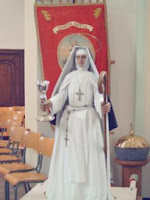 |
| Statue of Pope Saint Sylvester at the Church of Saint Sylvester Pisa, Italy |
History
Born in Rome and ordained by Pope Saint Marcellinus, Sylvester became pope only two years after Christianity had become legal. One of the most important gatherings in Church history happened during his papacy: the Council of Nice in 325, where hundreds of priests, bishops and theologians met to talk about what God wanted to do with the Church. But Pope Sylvester was too old to go. He sent two priests to represent him. When the Council ended. Pope Sylvester agreed with all their decisions, including the Nicene Creed
Activity
At every Sunday Mass, we stand together to pray the Nicene Creed. Read it together today. Do you know it by heart? If you memorize it, it’s easier to think through what the words mean as you say them at Mass. Work on memorizing the Creed today if you haven’t already.



.jpg)
_Stoning_of_Saint_Stephen.jpg)


.jpg)















